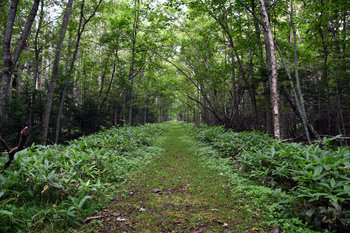Ghost Towns of the North, part 1 [Column_Pacific Rim]
 : former JNR Shihoro-Sen branch right of way between Nukabira and Horoka. Aug. 24, 2018
: former JNR Shihoro-Sen branch right of way between Nukabira and Horoka. Aug. 24, 2018Our summer vacation this year was the tour to Hokkaido, Japan. There, we visited several ghost towns along an abandoned railroad.
49 miles long Japanese National Railway’s Shihoro-Sen branch, extended north from Obihiro, Hokkaido, was completed in 1939[1]. Several towns were rapidly established next to the depots about that time. Unfortunately, however, the branch was abandoned in 1987 due to the lack of passengers and freights. Some of the towns along the branch declined antecedent to it, and some shared their fates with the branch.
 : April, 1980 Shihoro-Sen branch passenger timetable
: April, 1980 Shihoro-Sen branch passenger timetableWhat is interesting is that there are some matters common to both ghost towns along Rio Grande in Utah and ghost towns along JNR Shihoro-Sen branch in spite of different natural and social backgrounds.
First of all, it was surprising that both the towns are returning to nature so instantly. It was hard to imagine there used to be hundreds of people lived in the particular townsite.
Then, the last survived business in both the ghost towns seemed a mercantile, a “shoten” in Japanese, facing the depot. And, the last surviving structures in both the ghost towns are the post office and the power line.
Also is that both the towns are rich in nature: National Parks are within a stone's throw and wild animals stalk within the townsites.
I’ll introduce some of these ghost towns of the north in next post.
[1] Wikipedia webpage for JNR Shihoro-sen branch (Japanese only);
 : deer at JNR Mitsumata depot site
: deer at JNR Mitsumata depot site : pronghorn on US Hwy 6 at Cisco
: pronghorn on US Hwy 6 at Cisco夏の終わりに、酷暑から逃れようと、貯まったマイルを使って北海道へ旅行した。ところが、筆者らの旅程を追うが如くして、関西空港や北海道が災害に見舞われた。我々としては何ともいたたまれない気持ちである。被災された方々には改めてお見舞い申し上げる。
さて、この旅行では国鉄士幌線沿線の廃集落を通り抜けた。ところが、その情景が、気候も風土も全く違うにもかかわらず、本ブログで度々取り上げるアメリカ・ユタ州シスコにおけるそれに親しいのである。歴史などを少し調べてみると共通項があり、面白く思ったので紹介する。
面白く思ったひとつは、どちらもわずか40年ほどでほぼ自然に還っていること。とても、数百人もの人々が暮らしていたとは思えない廃れっぷりである。また、最後まで残っていたビジネスが駅前の商店であること。写真に遺されている、駅前の通りにポツンと商店がある光景は瓜二つである。更に、今に遺る建物が郵便局のそれであること、かつて駅舎や商店などに電力を供していた電柱だけが生き残っているのも同じである。
こじつければ、どちらも国立公園に近く、アーチに縁がある。最近大人気のアーチズ国立公園はユタ州シスコのすぐ近くであり、大雪山国立公園を有する上士幌町では、近年士幌線沿線に遺るアーチ橋群を観光資源にすべく整備を進めている。
対称的なのは、関連する歴史資料の貧富。シスコのそれがインターネットでも豊富に入手できるのに対し、士幌線沿線の廃村に関するそれはウェブ上にはほとんどない。公文書や地方紙などのアーカイブも見当たらない。系統立った資料は50年近く前に刊行された町史しかないのではないだろうか。家系や歴史に重きを置くモルモン教の影響を差し引いても、シスコひいてはユタ州に比べて、上士幌ひいては十勝における近代郷土史資料の収集・展示における乏しさは明らかで残念に思う。
2018-09-28 09:00
コメント(0)




コメント 0